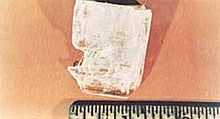Potassium sodium tartrate
| Potassium sodium tartrate | |
|---|---|
-tartrate.png) | |
 | |
| IUPAC name Potassium sodium tartrate | |
| Other names E337 | |
| Identifiers | |
| CAS number | 304-59-6 |
| PubChem | 9855836 |
| ChemSpider | 8031536 |
| UNII | QH257BPV3J |
| EC number | 206-156-8 |
| Jmol-3D images | {{#if:[K+].[Na+].O=C([O-])C(O)C(O)C([O-])=O|Image 1 |
| |
| |
| Properties | |
| Molecular formula | KNaC4H4O6·4H2O |
| Molar mass | 282.1 g/mol |
| Melting point | 75 °C |
| Boiling point | 220 °C |
| Solubility in water | 630 g/L (20 °C) [1] |
| Except where noted otherwise, data are given for materials in their standard state (at 25 °C (77 °F), 100 kPa) | |
| Infobox references | |
Potassium sodium tartrate is a double salt first prepared (in about 1675) by an apothecary, Pierre Seignette, of La Rochelle, France. As a result the salt was known as Seignette's salt or Rochelle salt. Rochelle salt is not to be confused with rock salt, which is simply the mineral form of sodium chloride. Potassium sodium tartrate and monopotassium phosphate were the first materials discovered to exhibit piezoelectricity.[2] This property led to its extensive use in "crystal" gramophone (phono) pick-ups, microphones and earpieces during the post-War consumer electronics boom of the mid-20th Century. Such transducers had an exceptionally high output with typical pick-up cartridge outputs as much as 2 volts or more. Rochelle salt is deliquescent so any transducers based on the material deteriorated if stored in damp conditions.
It is a colorless to blue-white salt crystallizing in the orthorhombic system. Its molecular formula is KNaC4H4O6·4H2O. It is slightly soluble in alcohol but more completely soluble in water. It has a specific gravity of about 1.79, a melting point of approximately 75 °C, and has a saline, cooling taste. As a food additive, its E number is E337.
It has been used medicinally as a laxative. It has also been used in the process of silvering mirrors. It is an ingredient of Fehling's solution, formerly used in the determination of reducing sugars in solutions.
In organic synthesis, it is used in aqueous workups to break up emulsions, particularly for reactions in which an aluminium-based hydride reagent was used.[3]
It is a common precipitant in protein crystallography and is also an ingredient in the Biuret reagent which is used to measure protein concentration. This ingredient maintains cupric ions in solution at an alkaline pH.
Preparation

Potassium sodium tartrate, (NaKC4H4O6) may be prepared by adding 0.5 mole sodium carbonate to heated solution containing 1 mole potassium bitartrate(KHC4H5O6). (1M KHC4H4O6 : 0.5M Na2CO3). The solution is filtered while hot. This solution is then dried to precipitate solid potassium sodium tartrate, as small crystallites.
Larger crystals of Rochelle salt have been grown under conditions of reduced gravity and convection on board Skylab .[4]
References
- ↑ http://www.chemblink.com/products/6381-59-5.htm
- ↑ Newnham, R.E.; Cross, L. Eric (November 2005). "Ferroelectricity: The Foundation of a Field from Form to Function". MRS Bulletin 30: pp. 845–846.
- ↑ Fieser, L. F.; Fieser, M., Reagents for Organic Synthesis; Vol.1; Wiley: New York; 1967, p. 983
- ↑ "SP-401 Skylab, Classroom in Space". NASA. Retrieved 2009-06-06.